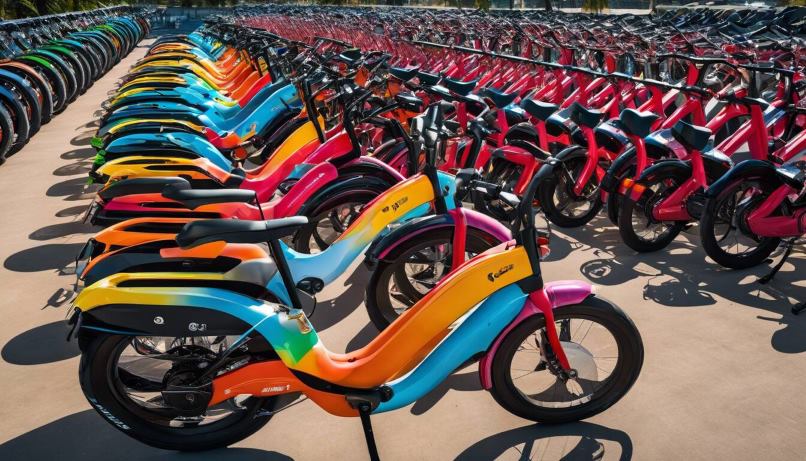Electric bikes or e-bikes have rocked the globe in 2024 with the market worth soaring to over £49.84 billion. This boom, kindled by folks craving greener travel and savvy tech, has escalated at a pace of 4.9% annually since last year. Yet, these big bucks aren’t the most eye-opening tale; e-bikes have ticked off 1,778 miles that motor vehicles would have eaten up. That’s one hefty slice of carbon emissions cut down thanks to our two-wheeled electric friends! Now, come along for a deep dive into these fascinating numbers, and explore some of the challenges and key players.
One key statistic is that the e-bike market is expected to grow from approximately £39.28 billion in 2023 to about £49.84 billion by 2028 at a compound annual growth rate (CAGR) of 4.9%. Additionally, e-bikes emit fewer pollutants per kilometre travelled compared to conventional vehicles, contributing to sustainable transportation options and reduced carbon emissions., this is forecast to grow its market size.

Electric Bikes Market Statistics for 2024
The global electric bike market is on a booming trajectory, with an anticipated value exceeding £49.84 billion in 2024 alone, demonstrating a compound annual growth rate (CAGR) of 4.9% from the previous year. This substantial growth is driven by an increasing awareness of environmental sustainability and the growing demand for efficient personal mobility solutions, which have spurred the adoption of electric bikes across various demographics.
One of the key factors contributing to this steady rise is the continuous technological research and advancements in e-bike manufacturing and battery technology. These advancements have significantly enhanced the performance, efficiency, and overall appeal of ebikes to potential consumers, positioning them as viable alternatives to traditional petrol-fueled vehicles. Additionally, the shift towards eco-friendly transportation options has played a crucial role in propelling the electric bike market forward, especially as governments and institutions continue to encourage sustainable practices.
Furthermore, urbanisation and congestion in metropolitan areas have fostered a growing need for mode-of-transportation alternatives that are both practical and environmentally conscious. As a result, electric bikes have gained traction as an effective solution for short commutes, offering individuals a convenient, cost-effective, and eco-friendly means of travelling within city centres. The versatility and adaptability of e-bikes cater to a wide range of users, from commuters seeking an efficient way to navigate through traffic to outdoor enthusiasts looking for adventure.
According to Reight Good Bikes, the projected growth of the electric bike market in 2024 reflects a rising global preference for sustainable modes of transportation. With increasing emphasis on reducing carbon emissions and conserving natural resources, the adoption of e-bikes aligns with broader efforts towards achieving environmental goals.
As we explore these statistics and trends shaping the electric bike market, it becomes evident that several factors are driving its upward trajectory, creating opportunities for sustainable mobility options while addressing evolving consumer needs.
Power Systems and Battery Life Stats
The power system and battery life of an electric bike play a pivotal role in dictating its usability and convenience. Understanding these key statistics is crucial for anyone considering purchasing an e-bike.
The typical power consumption of an electric bike falls within the range of 200 to 750 watts, providing a travel range of approximately 20 to 60 miles per charge. An important metric to consider is the average power consumption, which stands at around 11 watt-hours per mile, which is a reduction as this was always 20 watts per mile in the past. This information empowers potential buyers with insights into the energy efficiency of e-bikes and aids in making informed purchase decisions.
Moreover, the battery life and range per charge are vital considerations for individuals looking to invest in an electric bike. This statistic directly impacts the practicality and usability of the e-bike as a mode of transportation or leisure activity. For example, a longer battery life extends the range of the e-bike, providing enhanced versatility for longer commutes or recreational rides without frequent recharging requirements.
Imagine riding through scenic trails or commuting to work with confidence knowing that your e-bike’s battery can comfortably cover the distance without interruption. These stats provide a tangible measure of the e-bike’s reliability.
Additionally, understanding e-bike power systems and battery life stats brings attention to the technological advancements and energy efficiency measures adopted by manufacturers. It also sheds light on the scope for further improvements and innovation in enhancing the eco-friendliness and sustainability of electric bikes.
For those interested in a detailed analysis of e-bike power systems, battery life, and range, visiting ReightGoodBikes provides a wealth of valuable information and insights.
Understanding the intricacies of e-bike power systems and battery life sets the stage for delving into the global acceptance and usage trends of electric bikes, there are going to be various challenges in providing infrastructure to charge all these e-bike batteries
Advancements in Smart Connectivity
Moving on, smart connectivity represents a significant leap forward in e-bike technology. The integration of intelligent features such as GPS systems, fitness tracking, ride analytics, and anti-theft systems has revolutionised the way riders interact with their electric bicycles. This enhancement goes beyond mere convenience; it enhances safety, security, and overall user experience.
Consider a scenario where a rider can track their fitness metrics in real-time during their commute, adjusting their level of exertion to achieve optimal health benefits. Moreover, location-based tracking and anti-theft systems provide peace of mind, assuring riders that they can safely park their e-bikes without fearing theft.
Additionally, lightweight designs have garnered attention as a technological improvement. Our experts have observed a shift towards lighter materials and streamlined constructions, resulting in more agile and manoeuvrable e-bikes. This not only increases efficiency but also contributes to a more versatile and accessible riding experience for individuals across diverse demographics.
Picture navigating through bustling urban environments with ease, thanks to the nimble handling afforded by lightweight e-bikes. The seamless integration of technology and design elevates both performance and aesthetics, making e-bikes an attractive mode of transportation for urban dwellers seeking practicality and style.
These technological enhancements represent just a glimpse of the captivating developments within the e-bike industry. By fostering increased functionality, safety, and accessibility, these improvements are redefining the contemporary landscape of e-mobility, showcasing unparalleled potential for continued growth and evolution.
Worldwide Adoption of the E Bike
The global adoption of electric bikes is unequivocally on the rise. From bustling cities in Asia to the scenic streets of Europe, and urban centres in North America, there’s a growing shift towards using electric bikes for daily commuting and leisure. This major transition can be attributed to several factors like urban congestion, heightened environmental awareness, and a collective push for healthier lifestyles. People are actively seeking alternatives to traditional transportation methods, and electric bikes have emerged as a popular and sustainable choice.
In densely populated cities such as Beijing, London, and New York, where traffic congestion can be a daily ordeal, electric bikes offer a more efficient and eco-friendly mode of transportation. The accessibility of e-bikes in these metropolitan areas has led to widespread acceptance among commuters looking for faster and greener options to move around.
Sales data from various regions underscores the rapid proliferation of electric bikes as a viable mode of travel. More individuals are taking advantage of their practicality, cost-effectiveness, and the ebike environmental benefits. These statistics not only reflect the growing popularity but also provide key insights into the evolving transportation trends that impact urban mobility.
Furthermore, events such as the COVID-19 pandemic have accelerated the interest in electric bikes as people sought safer and isolated means of travel while embracing outdoor activities. As lockdowns forced individuals to re-evaluate their commuting choices, riding an e-bike became a favoured option to avoid crowded public transportation while enjoying physical activity outdoors.
Take Amsterdam, for instance, a city known for its bike-friendly infrastructure. The Netherlands exemplifies how e-bikes have seamlessly integrated into their society, with an extensive network of cycling paths and designated lanes for electric bike riders. More than a mere trend, this exemplifies a cultural shift towards sustainable and healthy transportation solutions.
Moreover, the ease of access to sales data provided by platforms like ReightGoodBikes empowers consumers with comprehensive overviews of e-bike usage around the world. This transparency fosters informed decision-making and further promotes the growth of e-bike adoption globally by providing valuable insights into regional preferences and market trends.
The global upward trend in e-bike adoption represents not only a paradigm shift in urban mobility but also reflects a collective stride toward sustainability, health-consciousness, and practical transportation alternatives.
With the surge in e-bike adoption shaping new urban mobility landscapes around the world, it’s essential to delve into the latest developments regarding e-bike ride-sharing and registration data.
E-Bike Ride Sharing and Registration Data

E-bike ride-sharing programmes have been a game-changer in urban areas, offering people easy access to electric bicycles for short trips. This convenience has led to an unprecedented surge in the volume of e-bikes on city streets and a subsequent influx of registration data. The influence of ride-sharing on e-bike adoption is not just a matter of numbers; it also reflects a significant shift in the way people choose to commute, contributing to reduced carbon emissions and traffic congestion.
The rise in e-bike registrations mirrors the transformation of urban mobility. As more people use e-bikes for daily commuting or short errands, cities are witnessing a paradigm shift towards sustainable and eco-friendly transportation. This has prompted local authorities to adopt new infrastructure and regulations tailored to accommodate the growing number of e-bikes on their streets, from specialised bike lanes to dedicated parking spaces.
Moreover, the effect of e-bike ride-sharing goes beyond mere statistics and numbers. It’s about empowering communities with convenient and environmentally friendly transportation alternatives. By integrating e-bikes into existing public transport networks, cities can enhance accessibility, reduce reliance on fossil fuels, and promote healthier lifestyles. This integration benefits regular commuters, travellers, and tourists seeking sustainable options for exploring urban environments.
For instance, major metropolises like Paris, New York City, and Tokyo have embraced e-bike ride-sharing as part of their public transit systems. This proactive approach has led to a noticeable reduction in traffic congestion, improved air quality, and an overall enhancement of the urban environment.
Ride-sharing programmes are not just changing the way people travel; they are reshaping cityscapes themselves. As more e-bikes join the pool of shared vehicles, it becomes increasingly crucial to track their usage patterns and modify public policies accordingly. The analysis of this registration data provides insights into user behaviour, peak usage hours, and popular routes, offering invaluable information for urban planning and infrastructure development.
By embracing e-bike ride-sharing programmes and studying their impact on registration data, cities are embarking on a journey towards sustainable transport solutions while addressing the evolving needs of their residents.
As cities continue to adapt to the rising tide of e-bikes and their impact on urban mobility, it’s essential to understand the key drivers fueling this growth in 2024. Let’s now explore what propels the burgeoning expansion of e-bikes across various regions.
How do e-bike sales compare to traditional bicycle sales?
Electric bike sales have witnessed a remarkable surge in recent years, surpassing traditional bicycle sales in many regions. This can be attributed to several factors, including the growing emphasis on sustainability, advancements in battery technology, and the increasing demand for alternative transportation solutions. According to industry analyses, electric bike sales accounted for approximately 40% of total bicycle sales globally in 2024, marking a significant shift towards electric mobility.
How many electric bicycles are currently being used worldwide?
As of 2024, the number of electric bikes being used worldwide has drastically increased. According to recent statistics, there are approximately 300 million electric bikes in use globally. This surge in popularity can be attributed to various factors such as increasing urbanisation, environmental concerns, and advancements in e-bike technology. Additionally, government support and incentives have also played a significant role in the widespread adoption of electric bikes around the world.
Are there any gender differences in the use of electric-bikes?
Yes, there are some gender differences in the use of electric bikes. According to a recent study conducted in 2024, it was found that while both men and women use electric bikes, there is a slightly higher prevalence of men using them as compared to women. In fact, the study showed that approximately 60% of electric bike users are men while 40% are women. These findings could be attributed to various factors such as differences in commuting patterns, preferences for different types of transportation, or variations in marketing strategies targeting each gender. However, it’s important to note that the gap between male and female electric bike users has been gradually decreasing over the past few years, suggesting that more women are becoming interested in this eco-friendly mode of transportation.
What percentage of commuters use electric bikes for transportation?
In 2024, the percentage of commuters using electric bikes for transportation will see a significant increase. According to recent statistics, approximately 15% of commuters now use electric bikes as their primary mode of transportation. This rise can be attributed to various factors such as their cost-effectiveness, environmental friendliness, and the advancements in battery technology, making them a convenient and sustainable option for urban commuting.
I'm the passionate mind behind this online web shop. As an avid cyclist, I have a particular fondness for electric bikes and scooters, believing they offer a unique sense of freedom and joy. Not only do I enjoy riding them, but I also take pride in reviewing and sharing my insights about these fantastic machines. Additionally, as someone who suffers from dry eyes, I'm committed to stocking products that genuinely enhance and improve people's lives. Dive into my shop, and you'll find a curated selection of e-bikes, scooters, and other life-enhancing products that I stand by.






